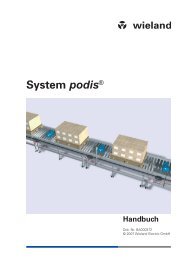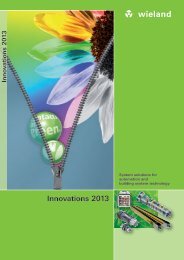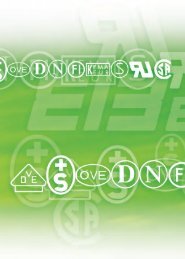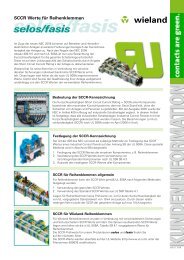safety - Catalogue (0860.1) - Wieland Electric
safety - Catalogue (0860.1) - Wieland Electric
safety - Catalogue (0860.1) - Wieland Electric
You also want an ePaper? Increase the reach of your titles
YUMPU automatically turns print PDFs into web optimized ePapers that Google loves.
S4000<br />
Basic device – SNO 4063K/KM<br />
Applications<br />
• Protection of people and machinery<br />
• Monitoring of emergency stop applications<br />
• Monitoring of <strong>safety</strong> gates<br />
• Monitoring of light barriers<br />
• Up to PL e / Category 4 (EN ISO 13849-1)<br />
• Up to SIL CL 3 (EN 62061)<br />
Features<br />
• Stop Category 0 according to EN 60204-1<br />
• Manual or automatic start<br />
• Cross monitoring<br />
• Single-channel or two-channel control<br />
• 3 enabling current paths<br />
Function<br />
SNO 4063K<br />
The device is a two-channel switching device for emergency stop applications<br />
with self-monitoring on each ON-OFF cycle. It complies with EN 60204-1 and<br />
is equipped with forcibly guided relays.<br />
Basic function<br />
After supply voltage has been applied to the A1/A2 terminals and the <strong>safety</strong><br />
inputs have been closed, pressing the reset button closes the enabling current<br />
paths (manual start). When the <strong>safety</strong> inputs are opened/de-energized the<br />
enabling current paths will open.<br />
Operating modes / system functions<br />
• Single or two-channel control With single-channel control both <strong>safety</strong><br />
channels, CH1 and CH2, are connected in parallel; with two-channel control<br />
they are switched separately. For AC devices, only two-channel operation<br />
with cross-connection monitoring is possible.<br />
• Without cross monitoring Both <strong>safety</strong> channels are switched to the positive<br />
potential (S12 and S31 to S11).<br />
• With cross monitoring Safety channel CH1 is switched to positive potential<br />
(S11 to S12), and <strong>safety</strong> channel CH2 to negative potential (S21 to S22).<br />
• Manual start When the <strong>safety</strong> inputs are closed, a button is used to open<br />
reset input S34 (triggering with falling edge) or to close reset input S35<br />
(triggering with rising edge).<br />
• Automatic start Reset input S35 is connected to S33. The device starts<br />
with the rising edge of the signal on <strong>safety</strong> input S12.<br />
• Start inhibit After supply voltage has been applied and the <strong>safety</strong> inputs<br />
closed, the enabling paths will not close. Starting is only possible after the<br />
reset button has been pressed. For start inhibit the reset inputs have to be<br />
controlled with the button, as with manual start mode.<br />
• Restart inhibit No restart after the <strong>safety</strong> inputs have been opened and<br />
closed. Restarting is only possible after the reset button has been pressed.<br />
For restart inhibit the reset inputs have to be activated with the button, as in<br />
manual start mode.<br />
• Semiconductor compatible OSSD (output signal switching devices) signals<br />
from a light curtain or other <strong>safety</strong> sensors with semiconductor outputs<br />
can be processed. Test pulses t TP can lock the device.<br />
SNO 4063KM<br />
The function of this device corresponds to that of the SNO 4063K. The device<br />
is suitable for connecting to light curtains for Type 4 (EN 61496-1) and to shortcircuit<br />
forming 4-wire <strong>safety</strong> mats, switching strips or switching edges (without<br />
monitoring resistance).<br />
• Safety mats The device must be operated with two channels and cross<br />
monitoring. If there is resistance < 50 Ω / channel and a short circuit between<br />
the channels (S11/S12 and S21/S22) the enabling paths open and the SUPPLY<br />
LEDs flash.<br />
• Light curtain for Type 4 (EN 61496-1) The device will be operated with<br />
two channels and without cross monitoring, if the light curtain connected to<br />
the OSSD detects a shunt fault on its own.<br />
For applications with tactile operating modes (rapid ON-OFF cycles, for example<br />
at manual supply) we recommend the use of SNO 4063KM.<br />
Circuit diagram<br />
SNO 4063K/KM<br />
42

















